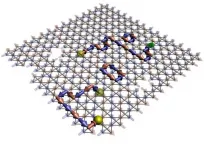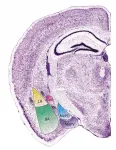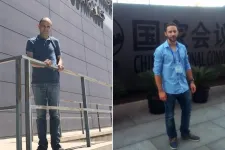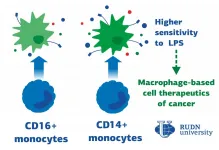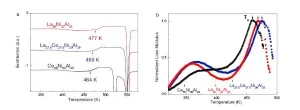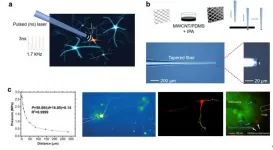NIH-funded study finds gene therapy may restore missing enzyme in rare disease
Results provide hope for children with aromatic L-amino acid decarboxylase deficiency
2021-07-16
(Press-News.org) WHAT:
A new study published in Nature Communications suggests that gene therapy delivered into the brain may be safe and effective in treating aromatic L-amino acid decarboxylase (AADC) deficiency. AADC deficiency is a rare neurological disorder that develops in infancy and leads to near absent levels of certain brain chemicals, serotonin and dopamine, that are critical for movement, behavior, and sleep. Children with the disorder have severe developmental, mood dysfunction including irritability, and motor disabilities including problems with talking and walking as well as sleep disturbances. Worldwide there have been approximately 135 cases of this disease reported.
In the study, led by Krystof Bankiewicz, M.D., Ph.D., professor of neurological surgery at Ohio State College of Medicine in Columbus, and his colleagues, seven children received infusions of the DDC gene that was packaged in an adenovirus for delivery into brain cells. The DDC gene is incorporated into the cells' DNA and provides instructions for the cell to make AADC, the enzyme that is necessary to produce serotonin and dopamine. The research team used magnetic resonance imaging to guide the accurate placement of the gene therapy into two specific areas of the midbrain.
Positron emission tomography (PET) scans performed three and 24 months after the surgery revealed that the gene therapy led to the production of dopamine in the deep brain structures involved in motor control. In addition, levels of a dopamine metabolite significantly increased in the spinal fluid.
The therapy resulted in clinical improvement of symptoms. Oculogyric crises, abnormal upward movements of the eyeballs, often with involuntary movements of the head, neck and body, that can last for hours and are a hallmark of the disease, completely went away in 6 of 7 participants. In some of the children, improvement was seen as early as nine days after treatment. One participant continued to experience oculogyric crises, but they were less frequent and severe.
All of the children exhibited improvements in movement and motor function. Following the surgery, parents of a majority of participants reported their children were sleeping better and mood disturbances, including irritability, had improved. Progress was also observed in feeding behavior, the ability to sit independently, and in speaking. Two of the children were able to walk with support within 18 months after receiving the gene therapy.
The gene therapy was well tolerated by all participants and no adverse side effects were reported. At three to four weeks following surgery, all participants exhibited irritability, sleep problems, and involuntary movements, but those effects were temporary. One of the children died unexpectedly seven months after the surgery. The cause of death was unknown but assessed to be due to the underlying primary disease.
INFORMATION:
WHO:
Jill Morris, Ph.D., program director, NIH's National Institute of Neurological Disorders and Stroke (NINDS). To arrange an interview, please contact nindspressteam@ninds.nih.gov
Article:
Pearson TS et al., Gene therapy for aromatic L-amino acid decarboxylase deficiency by MR-guided direct delivery of AAV2-AADC to midbrain dopaminergic neurons, Nature Communications, July 12, 2021.
This study was supported by NINDS (R01NS094292, NS073514-01).
For more information:
http://www.ninds.nih.gov
The NINDS is the nation's leading funder of research on the brain and nervous system. The mission of NINDS is to seek fundamental knowledge about the brain and nervous system and to use that knowledge to reduce the burden of neurological disease.
About the National Institutes of Health (NIH): NIH, the nation's medical research agency, includes 27 Institutes and Centers and is a component of the U.S. Department of Health and Human Services. NIH is the primary federal agency conducting and supporting basic, clinical, and translational medical research, and is investigating the causes, treatments, and cures for both common and rare diseases. For more information about NIH and its programs, visit http://www.nih.gov.
ELSE PRESS RELEASES FROM THIS DATE:
2021-07-16
LOS ALAMOS, N.M., July 15, 2021-- Using a D-Wave quantum-annealing computer as a testbed, scientists at Los Alamos National Laboratory have shown that it is possible to isolate so-called emergent magnetic monopoles, a class of quasiparticles, creating a new approach to developing "materials by design."
"We wanted to study emergent magnetic monopoles by exploiting the collective dynamics of qubits," said Cristiano Nisoli, a lead Los Alamos author of the study. "Magnetic monopoles, as elementary particles with only one magnetic pole, have been hypothesized by many, and famously by Dirac, but have proved elusive so far."
They realized an artificial spin ice by using the superconducting qubits of the quantum machine as a magnetic building block. Generating magnetic materials ...
2021-07-16
Great leaps in science and technology have been propelled by recent advances in seeing fast evolving physical phenomena, as they happen. Femtosecond lasers from the infrared to the X-ray region have enabled us to 'watch', in real time, atoms dance in molecules and solids on femtosecond and picosecond timescales. Watching such fascinating motions not just in real time but at the spatial locations where they happen, is a bigger challenge.
It is precisely this advance that has been made by a team of researchers at the Tata Institute of Fundamental Research, Mumbai, York University and the Rutherford Appleton Laboratories, UK [1]. They exploded a solid surface with an ultrahigh ...
2021-07-16
Fear is an important reaction that warns and protects us from danger. But when fear responses are out of control, this can lead to persistent fears and anxiety disorders. In Europe, about 15 percent of the population is affected by anxiety disorders. Existing therapies remain largely unspecific or are not generally effective, because the detailed neurobiological understanding of these disorders is lacking.
What was known so far is that distinct nerve cells interact together to regulate fear responses by promoting or suppressing them. Different circuits of nerve cells are involved in this process. A kind of "tug-of-war" takes place, with one brain circuit ...
2021-07-16
A new way of producing coherent light in the ultra-violet spectral region, which points the way to developing brilliant table-top x-ray sources, has been produced in research led at the University of Strathclyde.
The scientists have developed a type of ultra-short wavelength coherent light source that does not require laser action to produce coherence. Common electron-beam based light sources, known as fourth-generation light sources, are based on the free-electron laser (FEL), which uses an undulator to convert electron beam energy into X-rays.
Coherent light sources are powerful tools that enable research in many areas of medicine, biology, material sciences, chemistry and physics.
This new way of producing coherent radiation could revolutionise light sources, as it would ...
2021-07-16
In the field of industrial engineering, using simulations to model, predict and even optimise the response of a system or device is widespread, as it is less expensive and less complex -and, sometimes, less dangerous- than fabricating and testing several prototypes.
This type of simulation studies uses numerical methods that, depending on the problem to be addressed -for example, reducing the aerodynamic forces of an aircraft by changing its shape or using the minimum possible amount of material on elements under loading without breaking- require the simulation of a wide variety of possible combinational cases, which entails high computational costs.
The researchers from the School of Industrial Engineering of the University of Malaga Francisco Javier Granados Ortiz ...
2021-07-16
Neuro-evolutionary robotics is an attractive approach to realize collective behaviors for swarms of robots. Despite the large number of studies that have been devoted to it and although many methods and ideas have been proposed, empirical evaluations and comparative analyses are rare.
A publication in the journal Nature Communications, led by Mauro Birattari and his team at the research center IRIDIA, École Polytechnique de Bruxelles, Université Libre de Bruxelles, compares some of the most popular and advanced neuro-evolutionary methods for offline design of robot swarms.
"Concretely, these ...
2021-07-16
RUDN University biologists discovered the way how macrophages (the cells of the "first line" immune response) respond to inflammation and identified how the immune response depends on their origin. It turned out that when exposed to an inflammatory stimulus, two opposing mechanisms are activated in macrophages simultaneously -- inducing and inhibiting inflammation. These data can potentially be useful in the treatment of cancer, as targeted activation of macrophages will strengthen the immune response of the organism in the fight against a tumor. The results were published in the journal Biomedicine & Pharmacotherapy.
Macrophages are the cells responsible for phagocytosis -- they capture bacteria, the dead cells remains ...
2021-07-16
A collaborative group from Tohoku University and Johns Hopkins University have provided valuable insights into the glass transition.
When a liquid is cooled rapidly, it gains viscosity and eventually becomes a rigid solid glass. The point at which it does so is known as the glass transition.
But the exact physics behind the glass transition, and the nature of glass in general, still pose many questions for scientists.
Metallic Glasses (MGs) are highly sought after since they combine the flexibility of plastic with the strength of steel. They are amorphous materials with a disordered atomic structure and exhibit unique and divergent thermodynamic ...
2021-07-16
Neuromodulation at high spatial resolution has been an invaluable approach for treating neurological diseases and advancing fundamental knowledge in the field of neuroscience, as firing of a small population or even single neurons can specifically alter animal behavior or brain state. Optogenetics is a powerful method capable of modulating population neural activity in rodents, yet its requirement for viral transfection limits its applications in nonhuman primates and humans. As a rapidly growing modality, focused ultrasound has been harnessed in a myriad of brain neuromodulation applications. However, conventional piezo-based transducers offer a spatial resolution of several millimeters. It is also challenging ...
2021-07-16
JULY 15, 2021, NEW YORK - A Ludwig Cancer Research study has found that inducing random chromosome instability (CIN) events in mice for as little as one week is enough to trigger harmful chromosomal patterns in cells that spur the formation of tumors.
"We show that you don't need chronic, lifelong chromosomal mistakes to produce tumorigenesis at a quite respectable frequency," said Don Cleveland, Member of the Ludwig Institute for Cancer Research, San Diego, who led the study with Floris Foijer of the University of Groningen, in The Netherlands. "A very transient exposure would likely be sufficient to drive a very substantial increase in tumorigenesis."
The finding, detailed this week in the journal END ...
LAST 30 PRESS RELEASES:
[Press-News.org] NIH-funded study finds gene therapy may restore missing enzyme in rare disease
Results provide hope for children with aromatic L-amino acid decarboxylase deficiency
